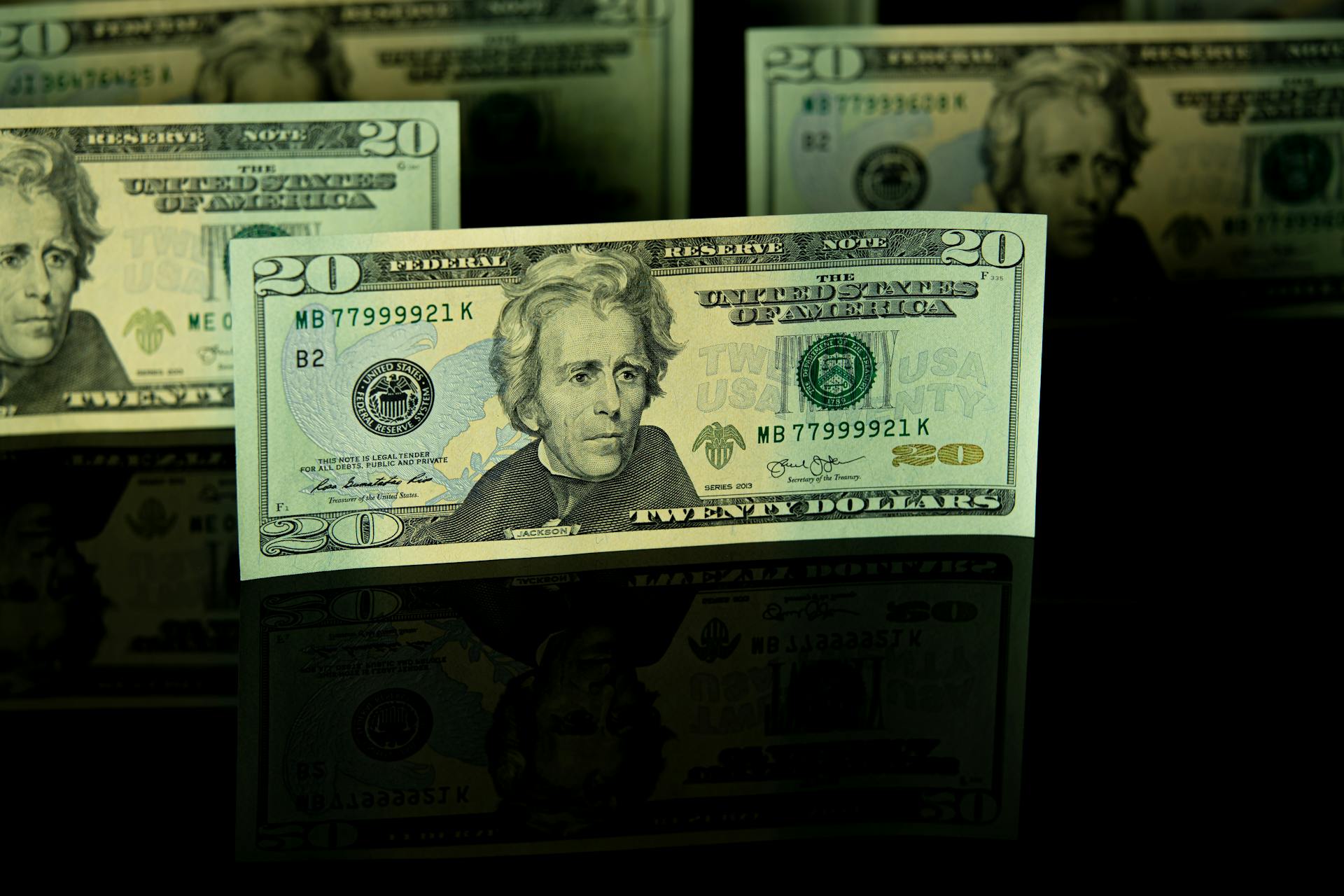
The US debt credit rating has been a topic of concern for many years, with the country's high levels of debt raising questions about its financial stability. The US government's debt-to-GDP ratio has been steadily increasing, reaching over 130% in 2020.
This has led to concerns about the country's ability to service its debt, with some rating agencies warning of a potential downgrade. The US government's reliance on borrowing to fund its activities has also led to increased scrutiny of its financial management.
The credit rating agency Standard & Poor's downgraded the US credit rating from AAA to AA+ in 2011, citing concerns about the country's fiscal policy. This downgrade had significant implications for the US economy, with higher borrowing costs and reduced investor confidence.
The US government's high debt levels have also raised questions about its ability to respond to future economic downturns. With a large and growing debt burden, the country may struggle to implement effective monetary and fiscal policies in times of crisis.
Credit Rating Issues
Credit rating agencies like S&P and Fitch have been warning about the US debt for years. In 2011, S&P issued a "negative" outlook on the US's "AAA" rating, citing a government budget deficit of over 11 percent of GDP.
This was the first time S&P had ever issued a negative outlook on the US rating. S&P considered the government budget deficit and net government debt to be high relative to other "AAA" countries.
Fitch also downgraded the US debt in 2023, citing debt ceiling brinkmanship and a widening federal deficit to GDP ratio of over 7%. Fitch noted that the government lacks a medium-term fiscal framework and that interest expenses are expected to reach 10% of tax revenue by 2025.
Moody's also warned about the risk of a default in 2011, citing the heightened polarization on both sides of the political process. Moody's recommended that Congress quickly raise the debt ceiling above $14.3 trillion.
Additional reading: Current U.s. Debt to Gdp Ratio
S&P put the US debt on a 90-day CreditWatch in July 2011, and Egan-Jones Rating Company, a smaller CRA, cut its rating from AAA to AA+ on July 16, 2011. This was the first time a NRSRO had downgraded the US rating.
Fitch noted that steady deterioration in standards of governance on fiscal and debt matters has eroded confidence in the government's ability to manage the debt.
Government Response
The government's response to the US debt crisis was a key factor in the credit rating agencies' decision to downgrade the country's credit rating. The US government's high level of debt and deficit spending led to a loss of investor confidence.
In 2011, the US government's debt-to-GDP ratio was 100%, significantly higher than the 60% threshold recommended by the International Monetary Fund (IMF). This high debt level raised concerns about the government's ability to pay its debts.
The credit rating agencies, including Standard & Poor's, Moody's, and Fitch, downgraded the US credit rating in response to the government's fiscal policies. The downgrade was a major concern for investors, as it increased the cost of borrowing for the US government.
2011
The year 2011 was a pivotal moment in the US government's history. The S&P downgrade occurred, marking the first time the US federal government was given a rating below AAA.
S&P had announced a negative outlook on the AAA rating in April 2011. This negative outlook led to a downgrade to AA+ just four days after the 112th United States Congress voted to raise the debt ceiling of the federal government by means of the Budget Control Act of 2011 on August 2, 2011.
The US Government commenced an investigation into S&P's role in the rating of several mortgage-backed securities which played a role in the 2008 financial crisis. S&P asked its then-CEO to step down in an effort to mend its relationship with the US government.
Deven Sharma stepped down as a Chief of Standard & Poor's effective September 12, 2011, and would leave the company by the end of the year.
2012
In 2012, Egan-Jones, a credit rating agency, took a series of rating cuts on the US government. The agency downgraded its rating twice that year.
The first downgrade occurred on April 5, 2012, when Egan-Jones cut its rating from AA+ to AA, citing a lack of progress on addressing the country's problems and a continued rise in debt to GDP.
Egan-Jones downgraded the US government's credit rating a third time on September 14, 2012, from AA to AA−, the lowest of what's considered "high grade."
2013
In 2013, the credit agency Fitch warned that it might cut the U.S. credit rating due to the political brinkmanship over raising the federal debt ceiling.
On October 17, 2013, Dagong Global Credit Rating downgraded the United States from A to A−, maintaining a negative outlook on the country's credit.
Fitch's warning in October 2013 highlighted the risks of political instability on the country's credit rating.
2014
In 2014, Fitch Ratings upgraded its outlook for the U.S. AAA credit rating on March 21, 2014. This move removed the nation from a downgrade watch after politicians put off another debt limit battle until the following year.
The upgrade changed the outlook for the rating to stable from a negative watch put in place in October. This change reflected the nation's efforts to address its financial concerns.
2019
In January 2019, Fitch Ratings warned that an extended government shutdown might lead to a downgrade in the U.S.'s credit rating.
This warning was issued because lawmakers were unable to pass a budget or manage the debt ceiling, which would make borrowing more costly for companies and American households.
The U.S.'s Triple-A credit rating is a benchmark for many other lines of credit, so a downgrade would have significant consequences for the economy.
Fitch Ratings' warning highlighted the importance of timely budget and debt ceiling management to avoid costly borrowing for companies and households.
2020
In 2020, Fitch Ratings gave the US a negative outlook on its long-term foreign currency and local current default ratings, despite reaffirming the AAA rating.
This change in outlook was due to the country's high debt levels and lack of a credible fiscal consolidation plan to address the economic shock caused by the Coronavirus disease 2019 pandemic.
Fitch noted that the US benefited from issuing debt in the world's reserve currency, but this advantage was not enough to offset the country's high debt burden.
The US government's debt was predicted to exceed 130% of GDP by 2021, highlighting the need for a comprehensive plan to manage the country's finances.
Governance and Policy Stability
Governance and policy stability have taken a hit in the US, with the 2011 debt-ceiling crisis bringing the country to the brink of default.
The effectiveness, stability, and predictability of American policymaking and political institutions have weakened, making it difficult for the government to address ongoing fiscal and economic challenges.
The statutory debt ceiling has become a political bargaining chip, used to debate fiscal policy. This has led to a lack of comprehensive fiscal consolidation plans, with only modest savings on discretionary spending agreed upon.
The plan to address the debt ceiling did not include new revenues, and only minor policy changes on Medicare were made, with little change in other entitlements.
The differences between political parties have proven to be difficult to bridge, making it hard for the government to find a solution to the debt crisis.
The Select Committee was tasked with making decisions on more comprehensive measures, but this has not led to a long-term fiscal sustainability solution.
The following highlights the key issues with the government's response to the debt crisis:
- Debt ceiling has become a political bargaining chip
- Only modest savings on discretionary spending agreed upon
- No new revenues included in the plan
- Minor policy changes on Medicare made
- Little change in other entitlements
This lack of stability and effectiveness in governance and policymaking has made it difficult for the government to address the ongoing fiscal and economic challenges facing the US.
Obama Administration
The Obama administration was quick to respond to the S&P downgrade, with officials publicly criticizing S&P's decision almost immediately after the announcement.
S&P's decision was made public on a Friday night, which likely contributed to the swift response from the administration. Obama administration officials were likely eager to address the situation before the weekend.
In the aftermath of the downgrade, the Obama administration faced criticism from Democratic politicians, who placed the blame on Republicans or elements of the Republican Party.
Republican Figures
Republican figures had strong opinions about the government's response to the credit rating downgrade.
Republican strategists blamed Democratic intransigence for the rating agency's decision.
Several Republican presidential candidates pointed fingers at President Obama for the economic woes.
Tim Pawlenty blamed Obama's leadership for the country's economic struggles, calling for a new direction and president.
Jon Huntsman criticized the government's spending and lack of leadership, advocating for new leadership committed to fiscal responsibility.
Mitt Romney echoed similar sentiments, blaming Obama's leadership for the economy's failures and calling for new leadership in the White House.
Rep. Michele Bachmann was particularly vocal, accusing Obama of destroying the credit rating through his economic policies and inability to control government spending.
She called for Obama to submit a plan with specific cuts to balance the budget and turn the economy around.
For your interest: Us Bank New Credit Card
Expert Analysis
The S&P downgrade of US sovereign debt was a significant event. On August 5, 2011, representatives from S&P announced the company's decision to give its first-ever downgrade to US sovereign debt.
The rating was lowered one notch to "AA+", with a negative outlook. This decision was a major concern for investors and policymakers alike.
In making this decision, S&P considered the country's creditworthiness and economic stability. The downgrade sent shockwaves through financial markets, with far-reaching implications for the US economy.
From Commentators
Several liberal commentators, including billionaire Warren Buffett and Nobel Memorial Prize winner Paul Krugman, criticized the downgrade. They pointed out that a downgrade might result in an increase in interest rates required to finance U.S. debt, potentially raising interest costs.
Filmmaker Michael Moore demanded that President Obama take action, suggesting that the head of Standard & Poor's be arrested. However, this reaction was not representative of the majority of commentators.
Commentators noted that the downgrade was partly due to an error in constructing discretionary spending levels underlying the analysis, which resulted in a $2 trillion higher deficit over 10 years than estimated by the Congressional Budget Office.
Fitch's Rational
Fitch's downgrade was due to debt ceiling brinkmanship, breached debt limit that required extraordinary measures by the Treasury, and the approaching x-date.
The federal deficit to GDP ratio of over 7% was a major concern, significantly higher than the 36.1% ratio for "AAA" peers.
Suggestion: Credit Cards for High Debt to Income Ratio
Fitch noted that Washington politicians narrowly beat the x-date to suspend the debt limit, but none of the structural and long-term concerns went away.
Steady deterioration in standards of governance on fiscal and debt matters eroded confidence, according to Fitch.
The government lacks a medium-term fiscal framework, especially with respect to rising social security and Medicare costs for an aging population.
Interest expenses are projected to reach 10% of tax revenue by 2025, compared to 2.8% for "AA" and 1% for "AAA" peers.
The 118.4% projected debt to GDP ratio in 2025 is over 2.5x higher than the "AAA" peers' 39.3% ratio.
See what others are reading: Does Debt to Income Ratio Affect Credit Score
Market and Consumer Impact
Global stock markets declined significantly on August 8, 2011, following the announcement of the credit rating downgrade. All three major U.S. stock indexes declined between five and seven percent in one day.
The cost to insure U.S. debts against default had risen from an average of around 25 basis points in 2007 to a range from 55 to 75 basis points in 2011. This indicates a higher risk of default.
A compromised credit rating could make U.S. Treasury bonds seem riskier and cause demand to decline, leading to higher interest rates for various types of loans, including mortgages and credit cards.
Revenues

Revenues play a significant role in shaping the market and consumer impact. S&P has revised their revenue assumptions, taking into account the 2001 and 2003 tax cuts. These tax cuts, initially set to expire by the end of 2012, have been extended due to Congressional resistance to revenue increases.
The majority of Republicans in Congress have consistently opposed measures to raise revenues, a stance reinforced by the passage of an act. This has led to a change in S&P's base case scenario, which now assumes the tax cuts remain in place.
Market Consequences
The market consequences of a credit rating downgrade can be significant. On August 8, 2011, global stock markets declined following the announcement, with all three major U.S. stock indexes declining between five and seven percent in one day.
The price of U.S. treasury bonds, however, rose, and the dollar gained value against the Euro and the British pound, indicating a flight to safe assets amid concerns about a European debt crisis.
The cost to insure U.S. debts against default had risen from an average of 25 basis points in 2007 to a range of 55 to 75 basis points in 2011, reflecting increased risk of default.
A credit rating downgrade can also lead to higher interest rates for various types of loans, including mortgages and credit cards. The 10-year U.S. Treasury yield is traditionally used as a benchmark for these interest rates.
Here's a breakdown of the potential impact on interest rates:
These increases can make borrowing more expensive for consumers, so it's essential to be aware of the potential market consequences of a credit rating downgrade.
LightStream Personal Loans
LightStream Personal Loans offer APRs ranging from 6.94% to 25.29% with AutoPay, and up to 0.50% points higher without it.
If you're looking for a personal loan, LightStream's options are quite flexible, covering purposes like debt consolidation, home improvement, auto financing, medical expenses, and more.
The loan amount ranges from $5,000 to $100,000, making it suitable for various needs.
You can choose a repayment period of 24 to 144 months, depending on the loan purpose.
To qualify for the lowest rate, you'll need excellent credit.
Here's an interesting read: Does a Business Line of Credit Affect Personal Credit
Reaction and Conclusion
The Biden administration officials strongly disagree with Fitch Ratings' decision to downgrade the US credit rating. They claim the change is arbitrary and based on outdated data.
Treasury Secretary Janet Yellen and White House press Secretary Karine Jean-Pierre expressed similar concerns about Fitch's modeling, while Senate Majority Leader Chuck Schumer blamed House Republicans for the downgrade. He stated that their "reckless brinksmanship and flirtation with default has negative consequences for the country."
The last time the US debt was downgraded was in 2011 by S&P, which also had significant market impacts.
Bottom Line
Moody's is the only rating firm that still gives the U.S. a AAA credit rating, despite other firms having already given it a black mark.
The potential for a downgrade looms on the horizon, which could make a lower APR loan a wise choice right now.
Democrats' Reaction
The Biden administration officials strongly disagreed with the Fitch Ratings' decision to downgrade the US debt.

Treasury Secretary Janet Yellen called the decision "arbitrary and based on outdated data."
White House press Secretary Karine Jean-Pierre also expressed her disagreement, citing concerns about Fitch's modeling.
Senate Majority Leader Chuck Schumer blamed House Republicans for the downgrade, saying their "reckless brinksmanship and flirtation with default has negative consequences for the country."
The last time the US debt was downgraded by another major credit rating agency was in 2011, when S&P downgraded the US debt.
Administration officials declined to speculate about whether other major credit rating agencies would follow Fitch's lead.
Fitch was the only one to have the US on a negative watch, and administration officials accused its modeling of being flawed.
Frequently Asked Questions
Is US Debt AAA rated?
No, the US debt is currently rated AA+, not AAA, following a downgrade by Fitch on August 1, 2023. This downgrade may lead to higher interest rates and increased reliance on foreign financing.
Does the US still have an AAA credit rating?
No, the US credit rating was downgraded from AAA to AA+ by Fitch Ratings on August 1, 2023. The downgrade indicates a change in the nation's creditworthiness, but more details can be found in our article on the credit rating change.
What is the credit rating of the United States?
The United States has a credit rating of 'AA+', indicating a high level of creditworthiness. This rating is assigned by Fitch Ratings and reflects a stable outlook for the country's long-term financial health.
Sources
- https://en.wikipedia.org/wiki/United_States_federal_government_credit-rating_downgrades
- https://www.cnbc.com/select/moodys-lowers-us-credit-outlook-to-negative/
- https://www.cnn.com/2023/08/01/business/fitch-downgrade-us-debt/index.html
- https://www.atlantafed.org/cenfis/publications/notesfromthevault/1108.aspx
- https://www.capitaladvisors.com/research/should-bondholders-worry-about-the-u-s-governments-recent-credit-rating-downgrade/
Featured Images: pexels.com


